A Field Theory-Based Novel Algorithm for Navigational Hazard Index
Abstract
1. Introduction
- (1)
- Based on the force constructed on the ship, the idea of field theory and multiple factors, a ship collision field model is established. The proposed navigational hazard index (NHI), using the potential field characterizing the index, transforms the ship domain overlapping problem into the field superposition problem and calculates the value in real time. The proposed algorithm can display the dangerous water level of the ship collision dynamically.
- (2)
- Considering the encounter situations, the NHI values are divided to make it reflect the risk level accurately. For the first time, the field-based concept is proposed to solve the problem of real-time evaluation of collision risk of ships in the process of encountering.
- (3)
- By providing real-time decision support for unmanned ships in actual operation, an on-board anti-collision decision-making system is applied and the automation level of an autonomous ship is promoted.
2. Materials and Methods
2.1. Ship Area Division
2.2. The Force on the Ship
2.2.1. Ship Gravity
2.2.2. Environmental Force
2.2.3. Ship Power
2.3. Stress Analysis of Ship
2.4. Single-Ship Collision Risk Field Model
2.5. Navigational Hazard Index (NHI)
2.6. Regionalization of the Collision Risk Index
2.7. Diagram of Three Two-Ship Encounter Situation Types
3. Instance Verification
3.1. Select Examples
3.2. Research on the Ship Collision Risk Index Based on Field Theory
3.2.1. Examples of the Two-Ship Encounter Situation
3.2.2. Examples of Multi-Ship Encounter Situation
4. Discussion
5. Conclusions
- (1)
- This paper proposes an algorithm of a navigational hazard index based on field theory, which complements and combines the traditional method of calculating the risk of ship collision and considers the two-ship encounter situation and the multi-ship encounter situation. The problem of domain overlap is transformed into the problem of field overlap. Finally, through the verification of an example, the results show that this method can accurately and stably obtain the NHI in real time and evaluate the risk level around the ship.
- (2)
- The strength of the approach appears in the capability to provide real-time change of the NHI in autonomous ships, so that the ship operating system can judge the current collision risk and take collision avoidance measures quickly. It can be applied to an on-board anti-collision decision-making system and promotes the automation level of an autonomous ship. It can not only improve the navigation safety of ships at sea, but also provide a reference for the application and development of intelligent navigation technology.
Author Contributions
Funding
Institutional Review Board Statement
Informed Consent Statement
Data Availability Statement
Conflicts of Interest
References
- Wu, B.; Yan, X.; Wang, Y.; Soares, C.G. An Evidential Reasoning-Based CREAM to Human Reliability Analysis in Maritime Accident Process. Risk Anal. 2017, 37, 1936–1957. [Google Scholar] [CrossRef] [PubMed]
- Annual Overview of Marine Casualties and Incidents 2019; European Maritime Safety Agency: Lisbon, Portugal, 2019.
- Wen, Y.; Huang, Y.; Zhou, C.; Yang, J.; Xiao, C.; Wu, X. Modelling of marine traffic flow complexity. Ocean. Eng. 2015, 104, 500–510. [Google Scholar] [CrossRef]
- He, Y.; Jin, Y.; Huang, L.; Xiong, Y.; Chen, P.; Mou, J. Quantitative analysis of COLREG rules and seamanship for autonomous collision avoidance at open sea. Ocean. Eng. 2017, 140, 281–291. [Google Scholar] [CrossRef]
- Kearon, J. Computer program for collision avoidance and track keeping. Proc. Conf. Math. Aspects Mar. Traffic. 1977, 229–242. [Google Scholar]
- Imazu, H.; Koyama, T. The Optimization of the Criterion for Collision Avoidance Action. J. Jpn. Inst. Navig. 1984, 71, 123–130. [Google Scholar]
- Imazu, H.; Koyama, T. The Valuation of a Criterion for Collision Avoidance Action. J. Jpn. Inst. Navig. 1986, 74, 117–123. [Google Scholar]
- Imazu, H.; Koyama, T. The Determination of Collision Avoidance Action. Collect. Pap. Jpn. Inst. Navig. 1984, 70, 31–37. [Google Scholar] [CrossRef]
- Kong, K.; Fang, X.L. Research on the Comprehensive Decision Method of Multi vessel Collision Avoidance Neural Network and Fuzzy Mathematic. In Proceedings of the 1995 Annual Academic Exchange Meeting of China; Institute of Navigation: Tianjin, China, 1995. [Google Scholar]
- Zhen, Z.Y.; Wu, Z.L. New model of collision risk between vessels. J. Dalian Marit. Univ. 2002, 28, 5. [Google Scholar]
- Sun, L.C. The Research on Mathematic Models of Decision-Making in Ship Collision Avoidance; Dalian Maritime University: Dalian, China, 2000. [Google Scholar]
- Zhou, J.H.; Wu, C.J. Construction of the collision risk factor model. J. Ningbo Univ. Sci. Eng. Ed. 2004, 17, 5. [Google Scholar]
- Smierzchalski, R.; Michalewicz, Z. Adaptive modeling of a ship trajectory in collision situations at sea. In Proceedings of the IEEE World Congress on IEEE International Conference on Evolutionary Computation, Anchorage, AK, USA; 1998. [Google Scholar] [CrossRef]
- Liu, J.P. Based on the Fuzzy Pattern Pattern Recognition of the Collision Risk Evaluation Mathod; Dalian Maritime University: Dalian, China, 2011. [Google Scholar]
- Zhang, Z.H. The Research of the Ship Collision Risk Model Based on Fuzzy Comprehensive Evaluation; Dalian Maritime University: Dalian, China, 2012. [Google Scholar]
- Liu, K.Z.; Wang, Z.X. Application of modified BP algorithm to calculate vessel collision risk degree. J. Wuhan Univ. Technol. 2003, 27, 412–414. [Google Scholar]
- Ji, Y.Q. Application of neural fuzzy system to vessel collision risk degree. J. Wuhan Univ. Technol. 2004, 05, 752–754. [Google Scholar]
- Li, B.; Pang, F.W. An approach of vessel collision risk assessment based on the D–S evidence theory. Ocean. Eng. 2013, 74, 16–21. [Google Scholar] [CrossRef]
- Mojarad, M.; Nejatian, S.; Parvin, H.; Mohammadpoor, M. A fuzzy clustering ensemble based on cluster clustering and iterative Fusion of base clusters. Appl. Intell. 2019, 49, 2567–2581. [Google Scholar] [CrossRef]
- Lv, H.G.; Yin, Y.; Yin, J.C.; Xu, W. Artificial intelligence and soft computation methods in automatic collision avoidance algorithms for ships. Navig. China 2016, 39, 35–40. [Google Scholar]
- Chin, H.C.; Debnath, A.K. Statistical analysis of conflict involvements in port water navigation. In Proceedings of the MARTECH 2008 Conference; Singapore Maritime Academy: Singapore; 2008. [Google Scholar]
- Debnath, A.K.; Chin, H.C.; Haque, M.M. Modelling port water collision risk using traffic conflicts. J. Navig. 2011, 64, 645–655. [Google Scholar] [CrossRef]
- Jha, A.; Kpr, B.; Yjy, B. A study on the collision avoidance of a ship using neural networks and fuzzy logic. Appl. Ocean. Res. 2012, 37, 162–173. [Google Scholar]
- Cong, Y.S. The Risk Analysis of Collision Accidents in Changxing Island Port; Dalian Maritime University: Dalian, China, 2015. (In Chinese) [Google Scholar]
- Cai, C.J. Study on Ship Collision Risk Based on Field Theory; Dalian Maritime University: Dalian, China, 2015. (In Chinese) [Google Scholar]
- Xue, W. The Risk Analysis of Collision in Dalian Port and Its Nearby Waters. Ph.D. Thesis, Dalian Maritime University, Dalian, China, 2013. (In Chinese). [Google Scholar]
- Yu, J.; Chen, J.; Xiao, Y.; Chen, T.; Sun, C. Navigation risk evaluation for curved fairways in Huangpu River based on multilevel fuzzy comprehensive assessment. J. Shanghai Marit. Univ. 2011, 32, 42–46. [Google Scholar]
- Wang, X.C. Research on Vessel Collision Risk in Laotieshan Area; Dalian Maritime University: Dalian, China, 2017. (In Chinese) [Google Scholar]
- Szlapczynski, R.; Szlapczynska, J. Review of ship safety domains: Models and applications. Ocean. Eng. 2017, 145, 277–289. [Google Scholar] [CrossRef]
- Fujii, Y. Traffic Capacity. J. Navig. 1971, 24, 543–552. [Google Scholar] [CrossRef]
- Goodwin, E.M. A Statistical Study of Ship Domains. J. Navig. 1975, 28, 328–344. [Google Scholar] [CrossRef]
- Ma, W.; Wang, H.; Wang, S. Critical Collision Risk Index Based on the Field Theory. Mar. Sci. Eng. 2022, 10, 1748. [Google Scholar] [CrossRef]
- Zheng, K.; Chen, Y.; Jiang, Y.; Qiao, S. A SVM based ship collision risk assessment algorithm. Ocean. Eng. 2020, 202, 107062. [Google Scholar] [CrossRef]
- Wang, N. Intelligent Quaternion Ship Domains for Spatial Collision Risk Assessment. J. Ship. Res. 2012, 56, 170–182. [Google Scholar] [CrossRef]
- Liu, D.D.; Shi, G.Y.; Li, W.F.; Chen, Z.H.; Jiang, J. Decision support of collision avoidance based on shortest avoidance distance and collision risk. J. Shanghai Marit. Univ. 2018, 39, 6. [Google Scholar]
- Jiang, X.; Zheng, H.T.; Jia, Z.P. Collision risk model based on quaternion ship domain and preventing collision regulations. Ship Eng. 2020, S01, 6. [Google Scholar]
- Ni, A.; Tu, N. Potential risk ship domain as a danger criterion for real-time ship collision risk evaluation. Ocean. Eng. 2019, 194, 106610. [Google Scholar]
- Zhang, L.; Meng, Q. Probabilistic ship domain with applications to ship collision risk assessment. Ocean. Eng. 2019, 186, 106130. [Google Scholar] [CrossRef]
- Lu, H. COLREGS-Constrained Real-time Path Planning for Autonomous Ships Using Modified Artificial Potential Fields. J. Navig. 2018, 72, 1–21. [Google Scholar] [CrossRef]
- Qiao, Z.; Zhang, Y.; Wang, S. A Collision Risk Identification Method for Autonomous Ships Based on Field Theory. IEEE Access 2021, 9, 30539–30550. [Google Scholar] [CrossRef]

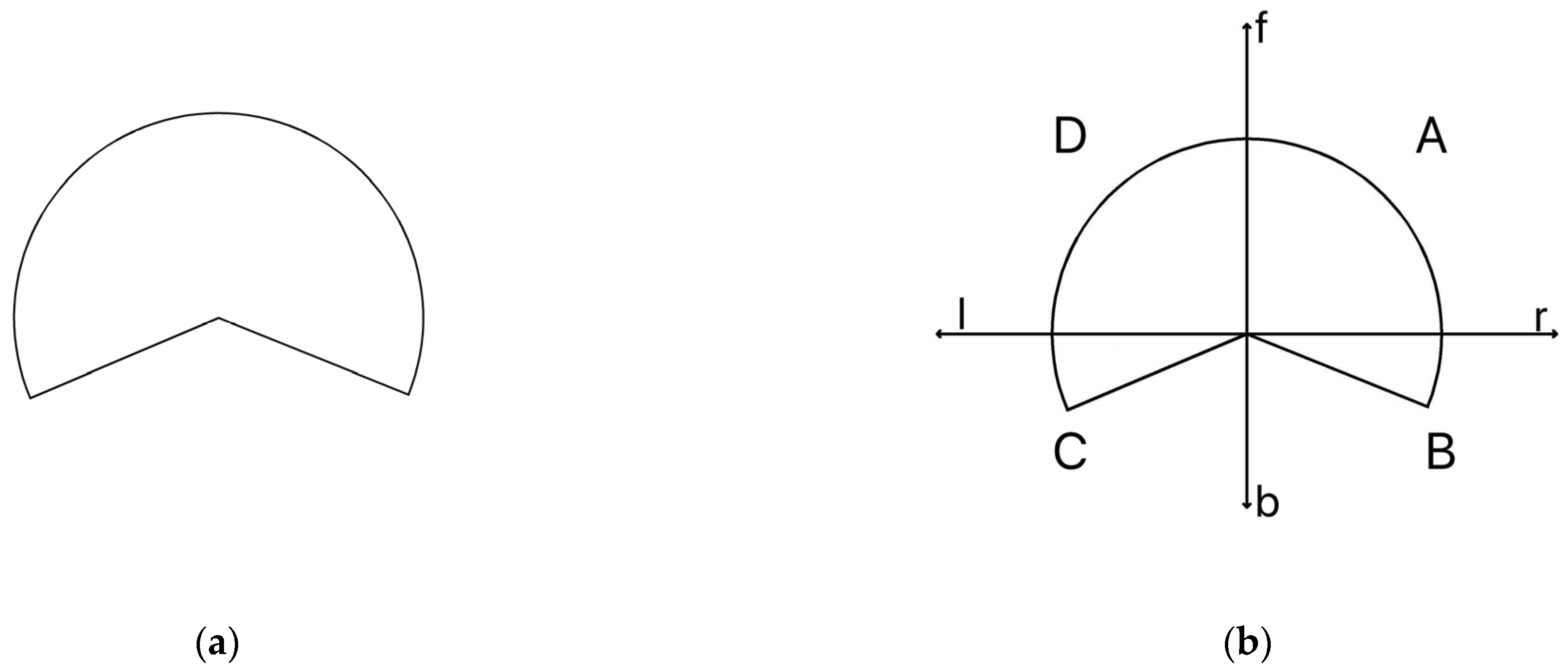
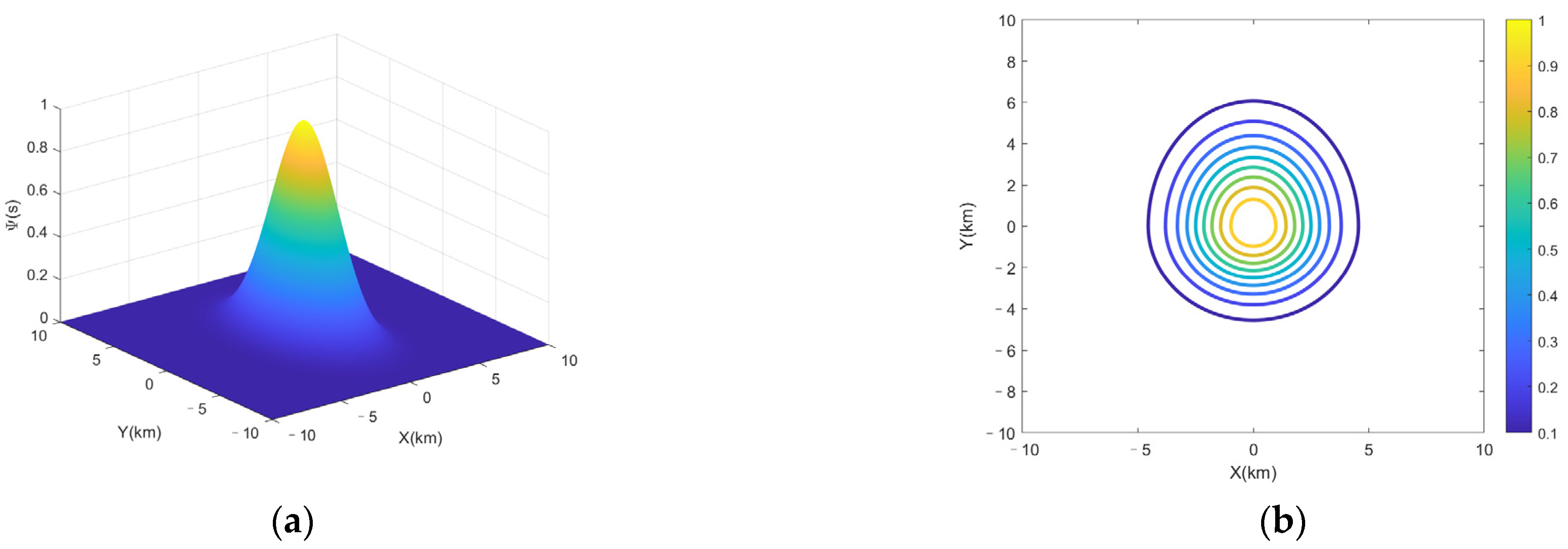
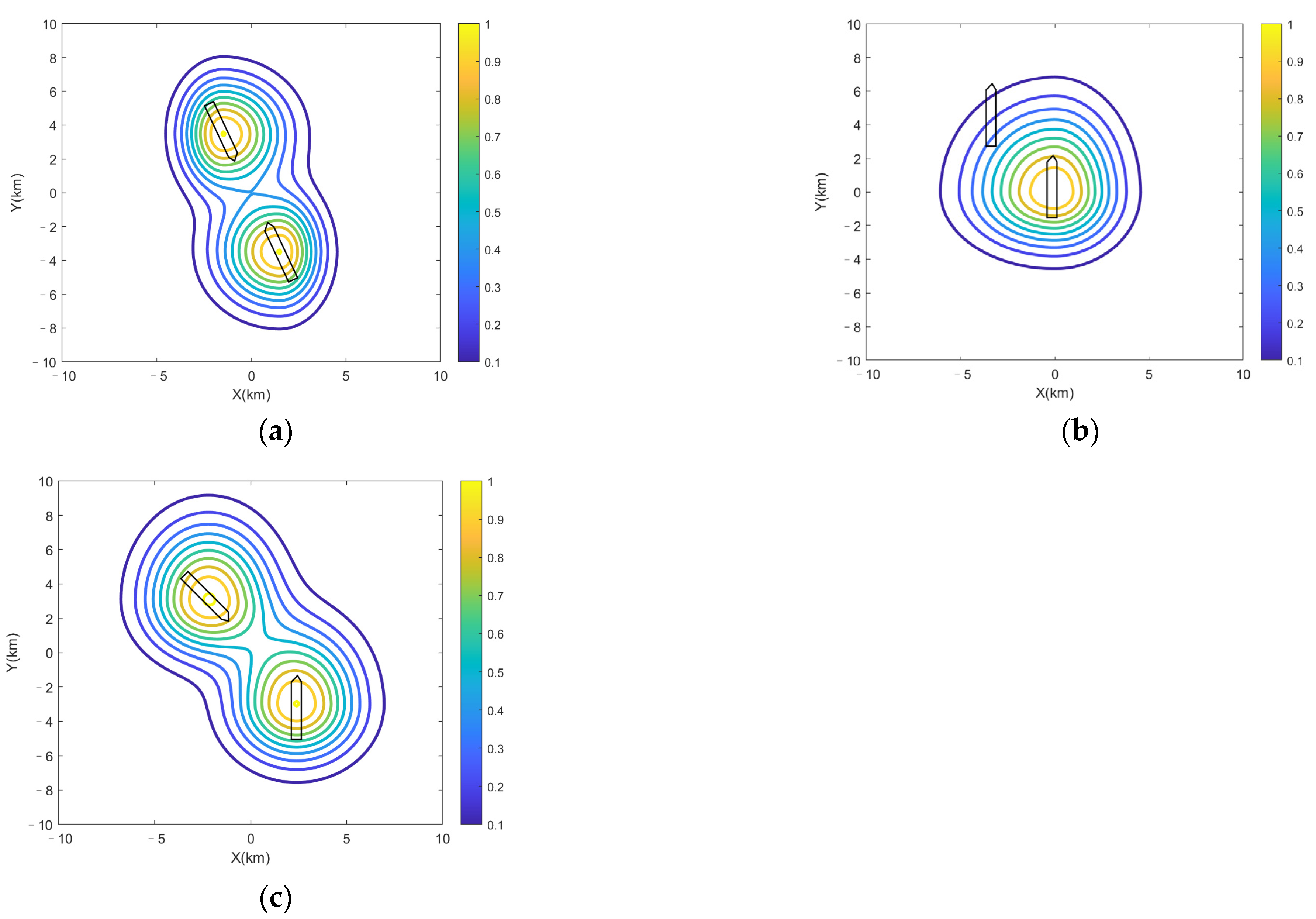

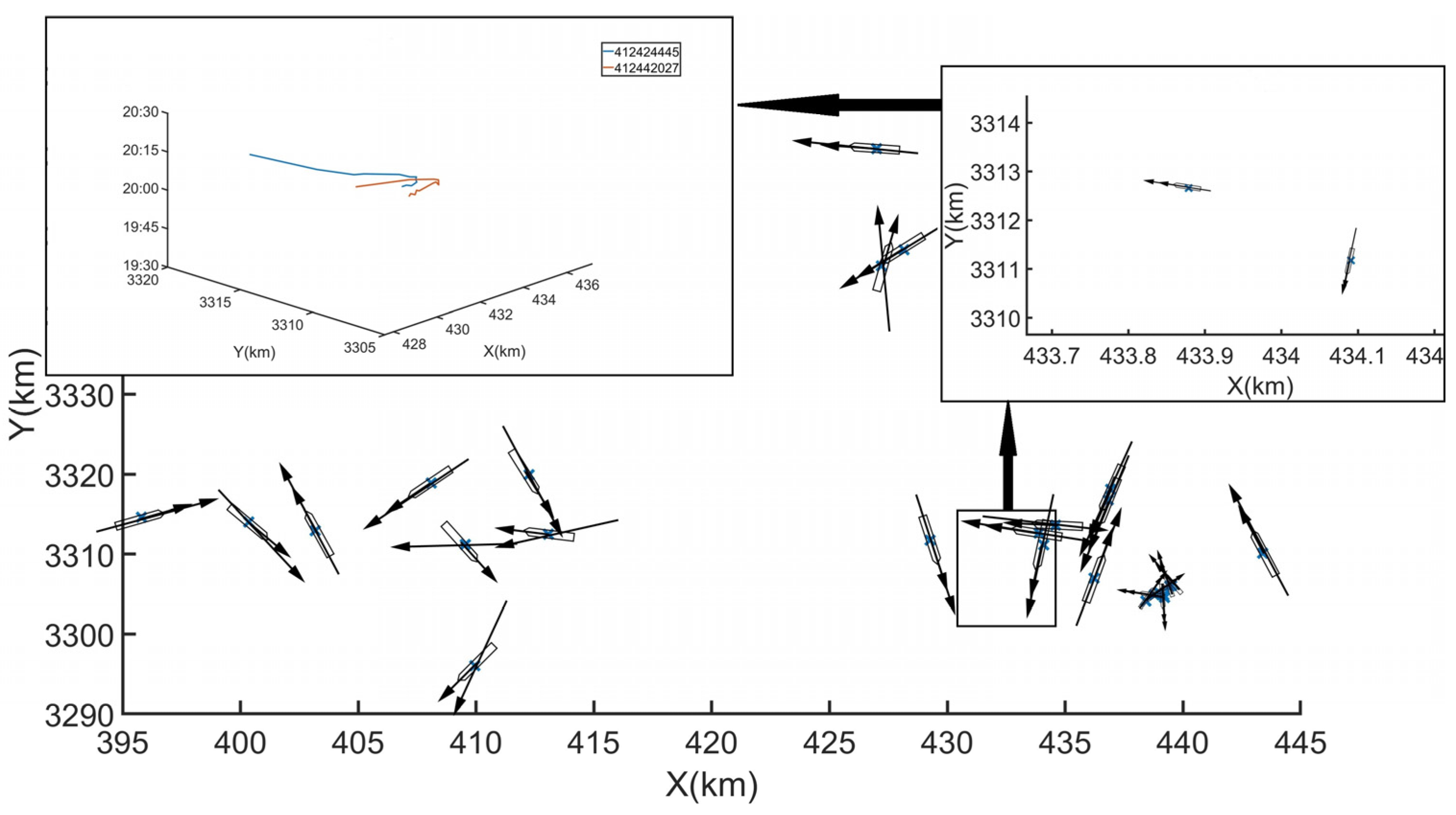

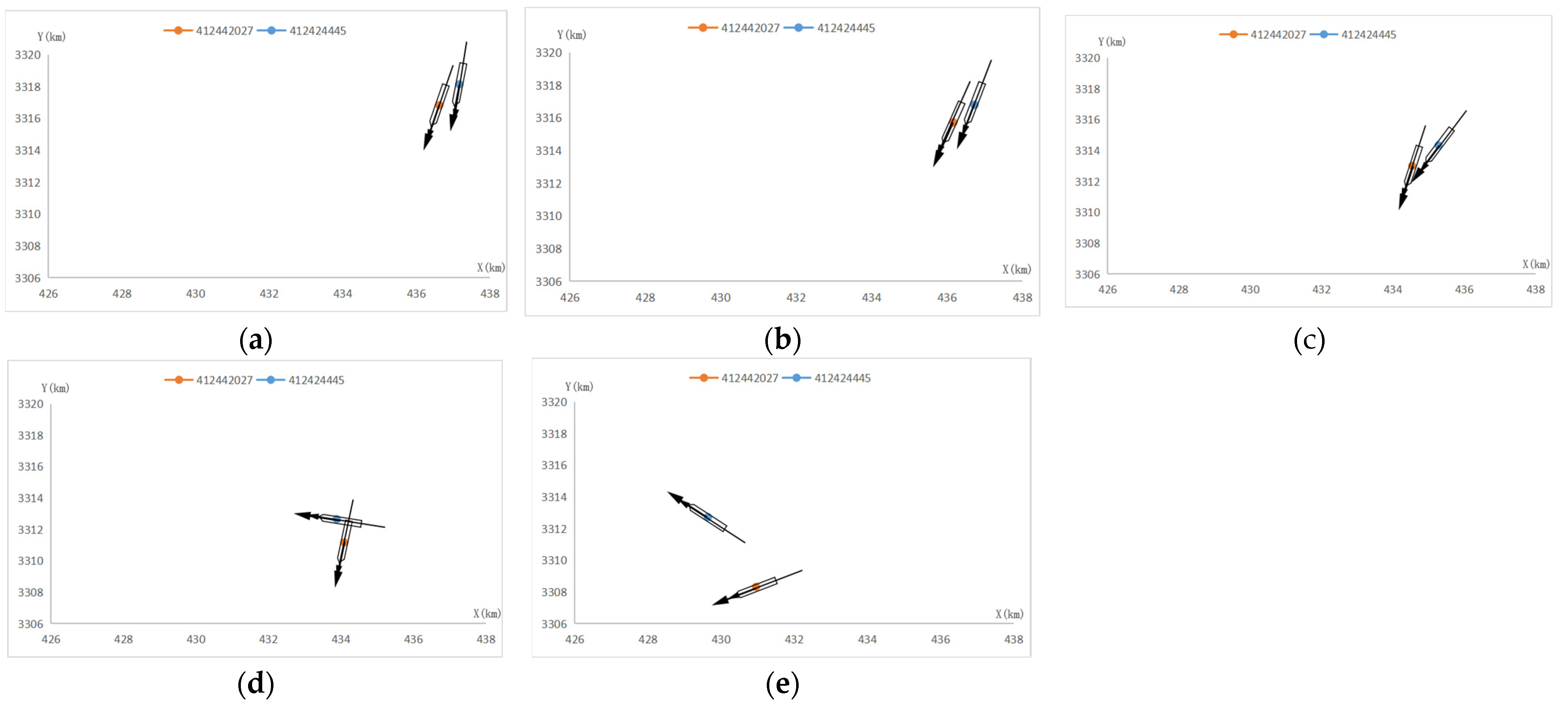
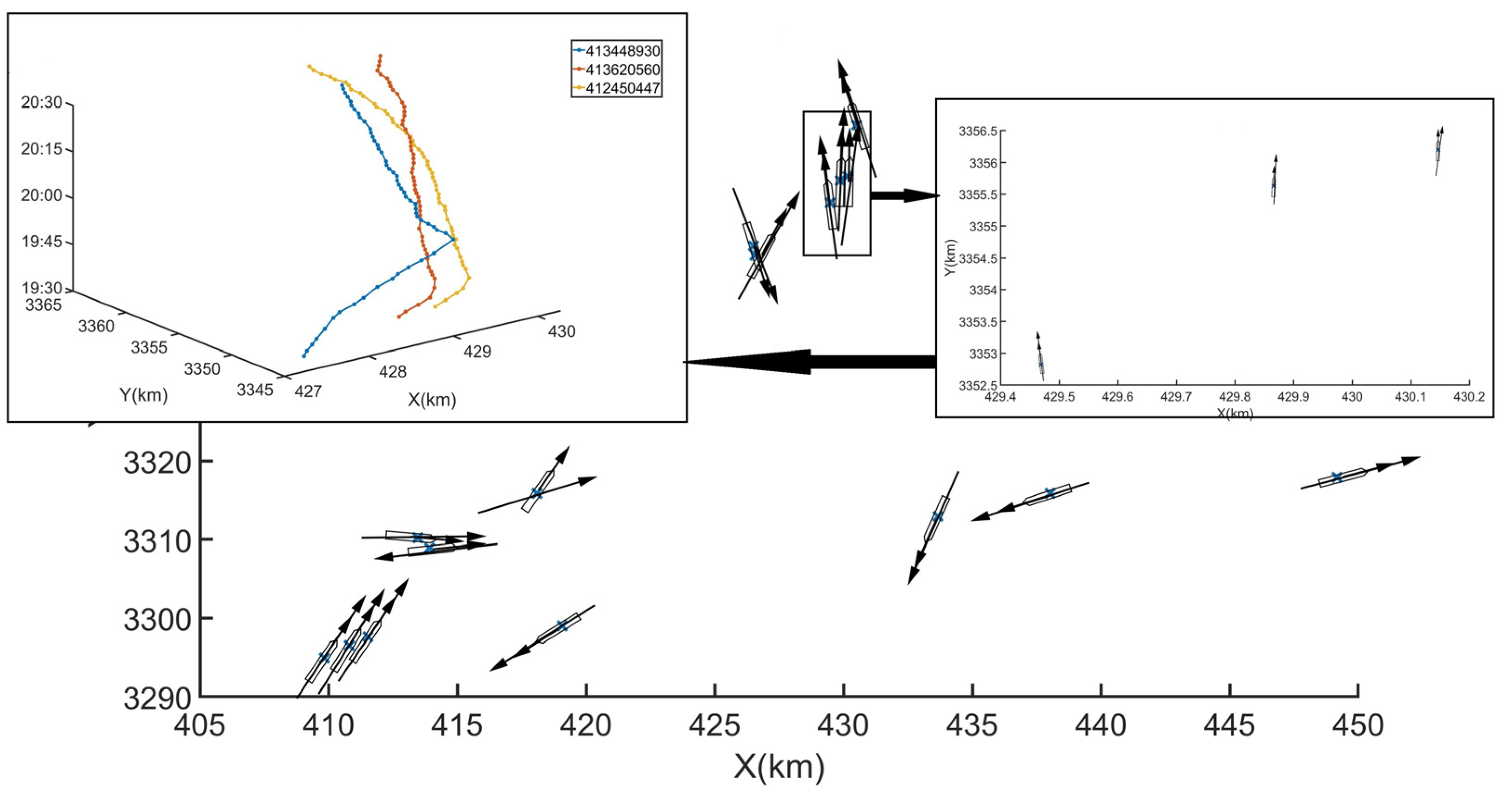


| Method by | Ship’s Length | Ship’s Speed | Two-Ship Encounter Situation | Multi-Ship Encounter Situation | Navigation Condition |
|---|---|---|---|---|---|
| Liu (2018) [35] | × | √ | × | × | × |
| Im and Lulong (2019) [37] | √ | √ | × | × | √ |
| Zhang and Meng (2019) [38] | √ | √ | × | × | × |
| Zheng (2020) [33] | √ | √ | √ | × | × |
| Jiang (2020) [36] | √ | √ | √ | × | × |
| Region | NHI | Definition Description |
|---|---|---|
| Safe Area | NHI = 0 | No risk of collision. |
| Caution Area | 0 < NHI ≤ 0.4 | The risk of collision is evident. |
| Action Area | 0.4 < NHI ≤ 0.8 | The risk of collision is obvious. |
| Emergency Braking Area | 0.8 < NHI ≤ 1 | The risk of collision is urgent. |
Disclaimer/Publisher’s Note: The statements, opinions and data contained in all publications are solely those of the individual author(s) and contributor(s) and not of MDPI and/or the editor(s). MDPI and/or the editor(s) disclaim responsibility for any injury to people or property resulting from any ideas, methods, instructions or products referred to in the content. |
© 2023 by the authors. Licensee MDPI, Basel, Switzerland. This article is an open access article distributed under the terms and conditions of the Creative Commons Attribution (CC BY) license (https://creativecommons.org/licenses/by/4.0/).
Share and Cite
Liu, Y.; Ma, Y. A Field Theory-Based Novel Algorithm for Navigational Hazard Index. J. Mar. Sci. Eng. 2023, 11, 178. https://doi.org/10.3390/jmse11010178
Liu Y, Ma Y. A Field Theory-Based Novel Algorithm for Navigational Hazard Index. Journal of Marine Science and Engineering. 2023; 11(1):178. https://doi.org/10.3390/jmse11010178
Chicago/Turabian StyleLiu, Yihua, and Yu Ma. 2023. "A Field Theory-Based Novel Algorithm for Navigational Hazard Index" Journal of Marine Science and Engineering 11, no. 1: 178. https://doi.org/10.3390/jmse11010178
APA StyleLiu, Y., & Ma, Y. (2023). A Field Theory-Based Novel Algorithm for Navigational Hazard Index. Journal of Marine Science and Engineering, 11(1), 178. https://doi.org/10.3390/jmse11010178






